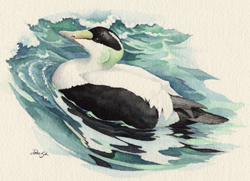Breeding Bird Atlases (BBA)
Find a Bird - BBA1
Breeding Bird Atlas 1 Species Accounts
Common Eider
Somateria mollissima
Egg Dates
late April to early July
Number of Broods
one; may re-lay if first attempt fails.

The Common Eider is a circumpolar breeder, nesting along coasts and on offshore islands. In the western North Atlantic, it breeds south regularly as far as the Casco Bay area of Maine. This large robust duck is most familiar as a wintering species in Massachusetts but is also now known to breed in the state in small numbers. There has been a dramatic overall population increase since the 1930s.
In 1975, Philip Stanton of Framingham State College began a program to establish the eider as a nesting species on the Elizabeth Islands. He collected eggs and ducklings from Casco Bay and hand-reared the birds, releasing them at various ages on Penikese Island for four years in succession. Some of these eiders survived and bred in subsequent seasons, producing a small nesting population on the southernmost islands of the Elizabeth chain. In 1984, a nest was discovered at Bird Island in Marion, and this indicated that the new range was expanding.
Small groups of eiders always have been present throughout the nesting season in the vicinity of Boston Harbor, Nantucket, Martha’s Vineyard, Cape Cod, and the rocky islands along the North Shore. A female eider with three young seen in Boston Harbor in 1982 almost certainly represents a natural range extension. It is possible that other breeding populations will result from these resident groups.
The heaviest migration in spring occurs during late March and early April. Males utter cooing notes and moans as they posture during courtship, and hens produce hoarse quacking sounds. Common Eiders may nest singly or in dense colonies at variable distances from the shore. Nests are ground depressions lined with some dried vegetation and a large quantity of insulating down pulled from the females’ breasts. They are often concealed by clumps of grass, bushes, or rocks. A normal clutch contains three to five olive green eggs, and incubation lasts an average of 28 days. Eiders in Maine begin nesting in late April, and the transplanted Massachusetts birds have adhered to the same schedule. Three Massachusetts nests each contained four eggs when observed on May 13 and May 30 (BOEM). Drakes abandon the hens at the end of laying or during early incubation and gather in their own flocks to molt.
Upon hatching, the brood is led to tidal pools along the ocean edge to begin feeding. Characteristically, Common Eiders merge their broods into large groups called crèches, with a number of females guarding the ducklings and brooding them at night while they are small. Brood dates for the state include July 6 (a female and six young) and July 24 (2 hens with five young) (BOEM). The juveniles require at least eight weeks to fledge. By that time, the adults have molted and renewed their flight feathers.
Common Eiders feed near rocky shores, diving for mollusks, worms, echinoderms, and crustaceans. Blue Mussels and Common Periwinkles are important foods. By late September, adults and immatures are flocking in preparation for migration. It is not known where the Massachusetts birds spend the winter, and some may be year-round residents. The bulk of the population occurs north of Long Island, New York. In early October, migrants begin to appear off the Massachusetts coast, and, by late November, Common Eiders occur by the thousands. Historically, especially large rafts of eiders have wintered offshore at Chatham.
Map Legend and Data Summary
Atlas 1 data collected from 1975-1979


Note: locally uncommon on Elizabeth Islands; introduced population in early 1970s
Augustus Ben David II



